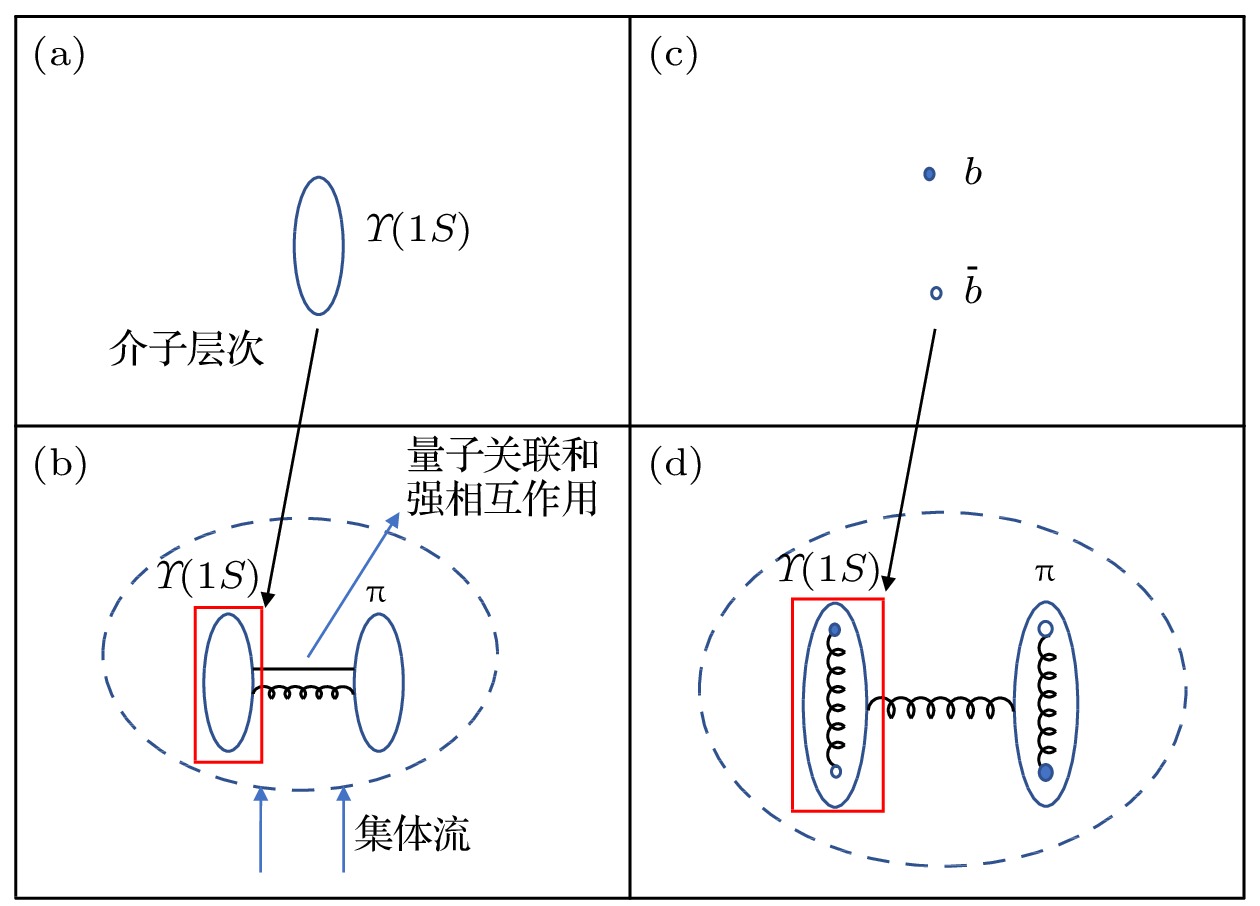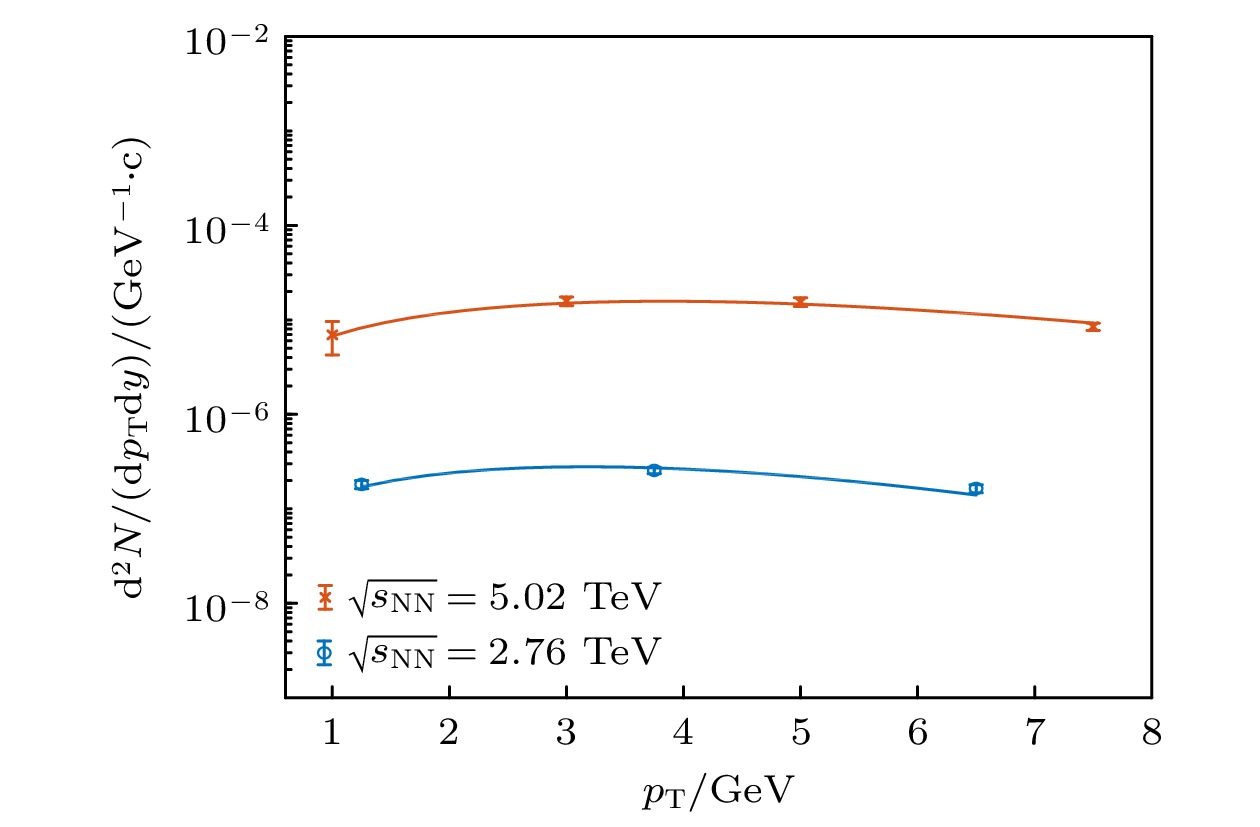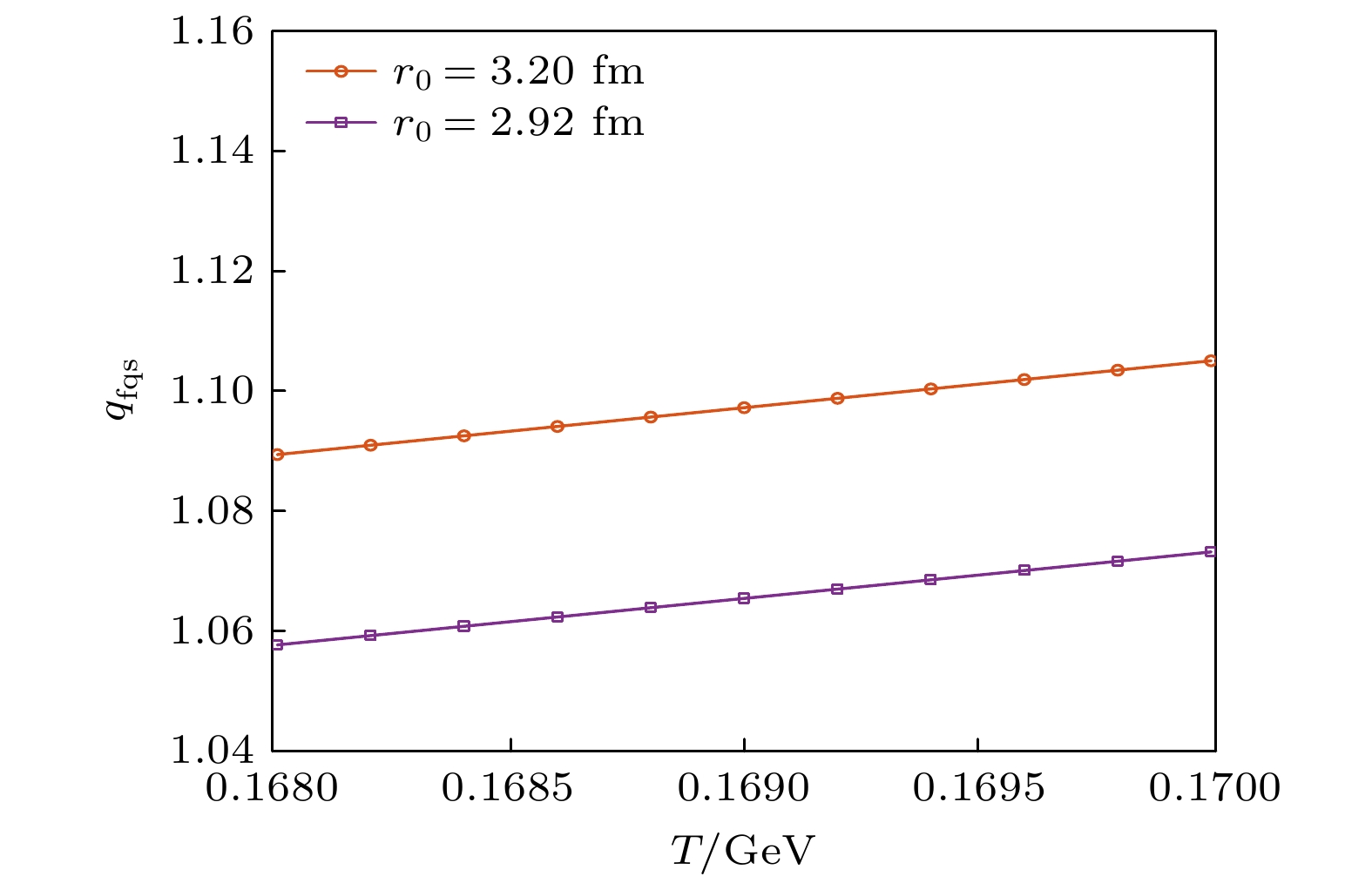-
$ \varUpsilon(1S) $ 是高能重离子碰撞中的干净探针, 其研究具有重要意义. 强子气体中$ \varUpsilon(1S) $ 的分布受到集体流、量子效应和强相互作用三种效应的影响. 此前的模型均只分析了其中一到两种效应而忽略了其他效应, 将忽略的效应放入到了拟合参数中. 本文从新的视角提出了两体分形模型, 从物理计算而非参数拟合的方法开展研究. 本文认为$ \varUpsilon(1S) $ 与最相近的介子形成两体结构, 与介子内部的两夸克结构具有自相似性. 引入环境影响因子$q_{{\rm{fqs}}}$ 来描述上述三种效应影响; 引入伴随因子$ q_2 $ 来描述$ b, \bar{b} $ 之间的相互作用和上述三种效应的影响. 通过求解概率与熵方程, 得到不同碰撞条件下$q_{{\rm{fqs}}}$ 与$ q_2 $ 的值. 将$q_{{\rm{fqs}}}$ 代入到分布函数中, 得到低横动量区的横动量谱并与实验对比, 结果表明理论与实验符合良好. 还分析了$q_{{\rm{fqs}}}$ 随温度的变化关系, 并发现$q_{{\rm{fqs}}}$ > 1, 这是由环境效应减少了$ \varUpsilon(1S) $ 的微观状态数所致. 另外, 计算显示$q_{{\rm{fqs}}}$ 随着系统温度的降低而减小, 这与随着系统膨胀强子气体影响减弱的现象相一致.The$ \varUpsilon(1S) $ meson serves as a reliable probe in heavy-ion collisions, as the regeneration process in the quark-gluon plasma (QGP) is negligible compared to$ J/\psi $ . Therefore, the distribution of$ \varUpsilon(1S) $ in the hadron gas provides valuable information about the QGP. Consequently, its study holds great significance. The distribution in the hadron gas is influenced by flow, quantum, and strong interaction effects. Previous models have predominantly focused on one or two of these effects while neglecting the others, resulting in the inclusion of unconsidered effects in the fitted parameters. In this paper, we aim to comprehensively examine all three effects simultaneously from a novel fractal perspective through physical calculations, rather than relying solely on data fitting. Close to the critical temperature, the combined action of the three effects leads to the formation of a two-meson structure comprising$ \varUpsilon(1S) $ and its nearest neighboring meson. However, with the evolution of the system, most of these states undergo disintegration. To describe this physical process, we establish a two-particle fractal (TPF) model. Our model proposes that, under the influence of the three effects near the critical temperature, a self-similarity structure emerges, involving a$ \varUpsilon(1S) $ -π two-meson state and a$ \varUpsilon(1S) $ -π two-quark state. As the system evolves, the two-meson structure gradually disintegrates. We introduce an influencing factor,$ q_{{\rm{fqs}}} $ , to account for the flow, quantum, and strong interaction effects, as well as an escort factor,$ q_2 $ , to represent the binding force between b and$ \bar{b} $ and the combined impact of the three effects. By solving the probability and entropy equations, we derive the values of$ q_{{\rm{fqs}}} $ and$ q_2 $ at various collision energies. Substituting the value of$ q_{{\rm{fqs}}} $ into the distribution function, we successfully obtain the transverse momentum spectrum of low-$ p_{\rm{T}} $ $ \varUpsilon(1S) $ , which demonstrates good agreement with experimental data. Additionally, we analyze the evolution of$ q_{{\rm{fqs}}} $ with temperature. Interestingly, we observe that$ q_{{\rm{fqs}}} $ is greater than 1 and decreases as the temperature decreases. This behavior arises from the fact that the three effects reduce the number of microstates, leading to$ q_{{\rm{fqs}}}>1 $ . The decrease in$ q_{{\rm{fqs}}} $ with system evolution aligns with the understanding that the influence of the three effects diminishes as the system expands. In the future, the TPF model can be employed to investigate other mesons and resonance states.-
Keywords:
- transverse momentum spectrum /
- fractal theory /
- escort probability /
- Tsallis entropy
[1] Lee K S, Heinz U, Schnedermann E 1990 Z. Phys. C: Part. Fields 48 525
 Google Scholar
Google Scholar
[2] Van Hove L 1982 Phys. Lett. B 118 138
 Google Scholar
Google Scholar
[3] Krämer M 2001 Prog. Part. Nucl. Phys. 47 141
 Google Scholar
Google Scholar
[4] Lansberg J P 2009 Eur. Phys. J. C 61 693
 Google Scholar
Google Scholar
[5] Brambilla N 2011 Eur. Phys. J. C 71 1534
 Google Scholar
Google Scholar
[6] Andronic A 2016 Eur. Phys. J. C 76 107
 Google Scholar
Google Scholar
[7] Mócsy Á, Petreczky P, Strickland M 2013 Int. J. Mod. Phys. A 28 1340012
 Google Scholar
Google Scholar
[8] Rapp R, Blaschke D, Crochet P 2010 Prog. Part. Nucl. Phys. 65 209
 Google Scholar
Google Scholar
[9] Rothkopf A 2020 Phys. Rep. 858 1
 Google Scholar
Google Scholar
[10] Zhao J, Zhou K, Chen S, Zhuang P 2020 Prog. Part. Nucl. Phys. 114 103801
 Google Scholar
Google Scholar
[11] Mócsy Á 2009 Eur. Phys. J. C 61 705
 Google Scholar
Google Scholar
[12] Karsch F, Mehr M T, Satz H 1988 Z. Phys. C: Part. Fields 37 617
 Google Scholar
Google Scholar
[13] Guo Y, Dong L, Pan J, Moldes M R 2019 Phys. Rev. D 100 036011
 Google Scholar
Google Scholar
[14] Kogut J B 1983 Rev. Mod. Phys. 55 775
 Google Scholar
Google Scholar
[15] Digal S, Petreczky P, Satz H 2001 Phys. Rev. D 64 094015
 Google Scholar
Google Scholar
[16] Burnier Y, Rothkopf A 2017 Phys. Rev. D 95 054511
 Google Scholar
Google Scholar
[17] Young C, Dusling K 2013 Phys. Rev. C 87 065206
 Google Scholar
Google Scholar
[18] Akamatsu Y, Rothkopf A 2012 Phys. Rev. D 85 105011
 Google Scholar
Google Scholar
[19] Zhou K, Xu N, Zhuang P 2014 Nucl. Phys. A 931 654
 Google Scholar
Google Scholar
[20] Herrmann N, Wessels J P, Wienold T 1999 Annu. Rev. Nucl. Part. Sci. 49 581
 Google Scholar
Google Scholar
[21] Schnedermann E, Sollfrank J, Heinz U 1993 Phys. Rev. C 48 2462
 Google Scholar
Google Scholar
[22] Wong C Y 2002 Phys. Rev. C 65 034902
 Google Scholar
Google Scholar
[23] Lin Z, Ko C M 2001 Phys. Lett. B 503 104
 Google Scholar
Google Scholar
[24] Abreu L M, Navarra F S, Nielsen M 2020 Phys. Rev. C 101 014906
 Google Scholar
Google Scholar
[25] Tang Z, Xu Y, Ruan L, van Buren G, Wang F, Xu Z 2009 Phys. Rev. C 79 051901
 Google Scholar
Google Scholar
[26] Reygers K, Schmah A, Berdnikova A, Sun X 2020 Phys. Rev. C 101 064905
 Google Scholar
Google Scholar
[27] Cleymans J, Satz H 1993 Z. Phys. C: Part. Fields 57 135
 Google Scholar
Google Scholar
[28] Andronic A, Braun-Munzinger P, Redlich K, Stachel J 2007 Nucl. Phys. A 789 334
 Google Scholar
Google Scholar
[29] Mandelbrot B 1967 Science 156 636
 Google Scholar
Google Scholar
[30] Li B A, Ko C M 1995 Phys. Rev. C 52 2037
 Google Scholar
Google Scholar
[31] Pathria R, Beale D P 2022 Formulation of Quantum Statistics (London:Elsevier) pp127–128
[32] Mandelbrot B 1982 The Fractal Geometry of Nature (New York: W. H. Freeman) pp25–74
[33] Dumitru A, Guo Y, Mócsy Á, Strickland M 2009 Phys. Rev. D 79 054019
 Google Scholar
Google Scholar
[34] Particle Data Group 2022 Prog. Theor. Exp. Phys. 2022 083C01
 Google Scholar
Google Scholar
[35] Srivastava P K, Chaturvedi O S K, Thakur L 2018 Eur. Phys. J. C 78 440
 Google Scholar
Google Scholar
[36] Crater H W, Yoon J H, Wong C Y 2009 Phys. Rev. D 79 034011
 Google Scholar
Google Scholar
[37] Ristea C 2018 Eur. Phys. J. Web Conf. 191 01004
 Google Scholar
Google Scholar
[38] Cè M, Harris T, Meyer H B, Toniato A, Török C 2021 J. High Energy Phys. 12 215
 Google Scholar
Google Scholar
[39] Beck C, Schögl F 1995 Thermodynamics of Chaotic Systems (Cambridge: Cambridge University Press) pp88–127
[40] Tél T 1988 Z. Naturforsch., A: Phys. Sci. 43 1154
 Google Scholar
Google Scholar
[41] Schroeder M 2009 Fractals, Chaos, Power Laws: Minutes from an Infinite Paradise (New York: W. H. Freeman and Company) pp103–121
[42] Abe S, Okamoto Y 2001 Nonextensive Statistical Mechanics and Its Applications (Berlin: Springer) pp5–6
[43] Tsallis C 1988 J. Stat. Phys. 52 479
 Google Scholar
Google Scholar
[44] Cleymans J, Worku D 2012 Eur. Phys. J. A 48 160
 Google Scholar
Google Scholar
[45] Beck C 2000 Physica A 286 164
 Google Scholar
Google Scholar
[46] CMS Collaboration 2017 Phys. Lett. B 770 357
 Google Scholar
Google Scholar
[47] CMS Collaboration 2019 Phys. Lett. B 790 270
 Google Scholar
Google Scholar
-
图 1 强子气体中b夸克和
$ \bar{b} $ 反夸克在不同层次的自相似结构 (a)真空中的自由$ \varUpsilon(1 S) $ 介子; (b)介子层次强子气体中的$ \varUpsilon(1 S) $ 介子; (c)真空中的自由b夸克和$ \bar{b} $ 反夸克; (d)夸克层次强子气体中的b夸克和$ \bar{b} $ 反夸克Fig. 1. Self-similarity structure of b quark and
$ \bar{b} $ anti-quark in hadron gas: (a) Free$ \varUpsilon(1 S) $ in vacuum; (b)$ \varUpsilon(1 S) $ in hadron gas from meson aspect; (c) free b and$ \bar{b} $ in vacuum; (d)$ \varUpsilon(1 S) $ in hadron gas from quark aspect图 2 Pb-Pb在不同碰撞能量以及0—100%碰撞对心度下, 低横动量
$ \varUpsilon(1 S) $ 介子在中心快度区间$ |y|<2.4 $ 的横动量谱. 实验数据来源于LHC[46,47]Fig. 2. Transverse momentum spectrum of low-
$ p_{\rm{T}}$ $ \varUpsilon(1 S) $ in Pb-Pb at different collision energies for 0–100% centrality, in mid-rapidity region$ |y| <2.4 $ . The experimental data are taken from LHC[46,47]表 1 Pb-Pb在不同碰撞能量以及0—100%碰撞对心度下, 中心快度区
$|y|<2.4$ 内的$\varUpsilon(1 S)$ 介子运动空间半径$r_0$ 的值Table 1. In mid-rapidity region
$|y|<2.4$ , radius$r_0$ of$\varUpsilon(1 S)$ motion space under different collision energies and 0–100% centrality for Pb-Pb碰撞能量($\sqrt{s_{\rm{NN}}}$) 2.76/TeV 5.02/TeV $r_0$/fm 2.92 3.20 表 2 Pb-Pb在不同碰撞能量以及0—100%碰撞对心度下, 中心快度区
$|y|<2.4$ 内影响因子$q_{{\rm{fqs}}}$ 和$q_2$ 的数值Table 2. In mid-rapidity region
$|y|<2.4$ , values of$q_{{\rm{fqs}}}$ and$q_2$ for Pb-Pb in 0–100% centrality at different collision energies碰撞能量 ($\sqrt{s_{\rm{NN}}}$ ) 2.76/TeV 5.02/TeV $q_{{\rm{fqs}}}$ 1.0732 1.1051 $q_{2}$ 1.4249 1.4144 -
[1] Lee K S, Heinz U, Schnedermann E 1990 Z. Phys. C: Part. Fields 48 525
 Google Scholar
Google Scholar
[2] Van Hove L 1982 Phys. Lett. B 118 138
 Google Scholar
Google Scholar
[3] Krämer M 2001 Prog. Part. Nucl. Phys. 47 141
 Google Scholar
Google Scholar
[4] Lansberg J P 2009 Eur. Phys. J. C 61 693
 Google Scholar
Google Scholar
[5] Brambilla N 2011 Eur. Phys. J. C 71 1534
 Google Scholar
Google Scholar
[6] Andronic A 2016 Eur. Phys. J. C 76 107
 Google Scholar
Google Scholar
[7] Mócsy Á, Petreczky P, Strickland M 2013 Int. J. Mod. Phys. A 28 1340012
 Google Scholar
Google Scholar
[8] Rapp R, Blaschke D, Crochet P 2010 Prog. Part. Nucl. Phys. 65 209
 Google Scholar
Google Scholar
[9] Rothkopf A 2020 Phys. Rep. 858 1
 Google Scholar
Google Scholar
[10] Zhao J, Zhou K, Chen S, Zhuang P 2020 Prog. Part. Nucl. Phys. 114 103801
 Google Scholar
Google Scholar
[11] Mócsy Á 2009 Eur. Phys. J. C 61 705
 Google Scholar
Google Scholar
[12] Karsch F, Mehr M T, Satz H 1988 Z. Phys. C: Part. Fields 37 617
 Google Scholar
Google Scholar
[13] Guo Y, Dong L, Pan J, Moldes M R 2019 Phys. Rev. D 100 036011
 Google Scholar
Google Scholar
[14] Kogut J B 1983 Rev. Mod. Phys. 55 775
 Google Scholar
Google Scholar
[15] Digal S, Petreczky P, Satz H 2001 Phys. Rev. D 64 094015
 Google Scholar
Google Scholar
[16] Burnier Y, Rothkopf A 2017 Phys. Rev. D 95 054511
 Google Scholar
Google Scholar
[17] Young C, Dusling K 2013 Phys. Rev. C 87 065206
 Google Scholar
Google Scholar
[18] Akamatsu Y, Rothkopf A 2012 Phys. Rev. D 85 105011
 Google Scholar
Google Scholar
[19] Zhou K, Xu N, Zhuang P 2014 Nucl. Phys. A 931 654
 Google Scholar
Google Scholar
[20] Herrmann N, Wessels J P, Wienold T 1999 Annu. Rev. Nucl. Part. Sci. 49 581
 Google Scholar
Google Scholar
[21] Schnedermann E, Sollfrank J, Heinz U 1993 Phys. Rev. C 48 2462
 Google Scholar
Google Scholar
[22] Wong C Y 2002 Phys. Rev. C 65 034902
 Google Scholar
Google Scholar
[23] Lin Z, Ko C M 2001 Phys. Lett. B 503 104
 Google Scholar
Google Scholar
[24] Abreu L M, Navarra F S, Nielsen M 2020 Phys. Rev. C 101 014906
 Google Scholar
Google Scholar
[25] Tang Z, Xu Y, Ruan L, van Buren G, Wang F, Xu Z 2009 Phys. Rev. C 79 051901
 Google Scholar
Google Scholar
[26] Reygers K, Schmah A, Berdnikova A, Sun X 2020 Phys. Rev. C 101 064905
 Google Scholar
Google Scholar
[27] Cleymans J, Satz H 1993 Z. Phys. C: Part. Fields 57 135
 Google Scholar
Google Scholar
[28] Andronic A, Braun-Munzinger P, Redlich K, Stachel J 2007 Nucl. Phys. A 789 334
 Google Scholar
Google Scholar
[29] Mandelbrot B 1967 Science 156 636
 Google Scholar
Google Scholar
[30] Li B A, Ko C M 1995 Phys. Rev. C 52 2037
 Google Scholar
Google Scholar
[31] Pathria R, Beale D P 2022 Formulation of Quantum Statistics (London:Elsevier) pp127–128
[32] Mandelbrot B 1982 The Fractal Geometry of Nature (New York: W. H. Freeman) pp25–74
[33] Dumitru A, Guo Y, Mócsy Á, Strickland M 2009 Phys. Rev. D 79 054019
 Google Scholar
Google Scholar
[34] Particle Data Group 2022 Prog. Theor. Exp. Phys. 2022 083C01
 Google Scholar
Google Scholar
[35] Srivastava P K, Chaturvedi O S K, Thakur L 2018 Eur. Phys. J. C 78 440
 Google Scholar
Google Scholar
[36] Crater H W, Yoon J H, Wong C Y 2009 Phys. Rev. D 79 034011
 Google Scholar
Google Scholar
[37] Ristea C 2018 Eur. Phys. J. Web Conf. 191 01004
 Google Scholar
Google Scholar
[38] Cè M, Harris T, Meyer H B, Toniato A, Török C 2021 J. High Energy Phys. 12 215
 Google Scholar
Google Scholar
[39] Beck C, Schögl F 1995 Thermodynamics of Chaotic Systems (Cambridge: Cambridge University Press) pp88–127
[40] Tél T 1988 Z. Naturforsch., A: Phys. Sci. 43 1154
 Google Scholar
Google Scholar
[41] Schroeder M 2009 Fractals, Chaos, Power Laws: Minutes from an Infinite Paradise (New York: W. H. Freeman and Company) pp103–121
[42] Abe S, Okamoto Y 2001 Nonextensive Statistical Mechanics and Its Applications (Berlin: Springer) pp5–6
[43] Tsallis C 1988 J. Stat. Phys. 52 479
 Google Scholar
Google Scholar
[44] Cleymans J, Worku D 2012 Eur. Phys. J. A 48 160
 Google Scholar
Google Scholar
[45] Beck C 2000 Physica A 286 164
 Google Scholar
Google Scholar
[46] CMS Collaboration 2017 Phys. Lett. B 770 357
 Google Scholar
Google Scholar
[47] CMS Collaboration 2019 Phys. Lett. B 790 270
 Google Scholar
Google Scholar
计量
- 文章访问数: 4222
- PDF下载量: 80
- 被引次数: 0






































 下载:
下载:





















